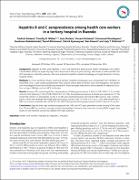| dc.contributor.author | Kateera, Fredrick | |
| dc.contributor.author | Walker, Timothy D | |
| dc.contributor.author | Mutesa, Leon | |
| dc.contributor.author | Mutabazi, Vincent | |
| dc.contributor.author | Musabeyesu, Emmanuel | |
| dc.contributor.author | Mukabatsinda, Constance | |
| dc.contributor.author | Bihizimana, Pascal | |
| dc.contributor.author | Kyamanywa, Patrick | |
| dc.contributor.author | Karenzi, Ben | |
| dc.contributor.author | Orikiiriza, Judy T | |
| dc.date.accessioned | 2022-04-11T07:42:32Z | |
| dc.date.available | 2022-04-11T07:42:32Z | |
| dc.date.issued | 2015 | |
| dc.identifier.citation | Kateera, F., Walker, T.D., Mutesa, L., Mutabazi, V., Musabeyesu, E., Mukabatsinda, C., Bihizimana, P., Kyamanywa, P., Karenzi, B. and Orikiiriza, J.T. (2015). Hepatitis B and C seroprevalence among health care workers in a tertiary hospital in Rwanda. Transactions of the Royal Society of Tropical Medicine and Hygiene, 109(3), pp.203-208. | en_US |
| dc.identifier.issn | 0035-9203 / 1878-3503 | |
| dc.identifier.uri | http://hdl.handle.net/20.500.12280/2933 | |
| dc.description.abstract | Background
Hepatitis B (HBV) and hepatitis C (HCV) are significant global public health challenges with health care workers (HCWs) at especially high risk of exposure in resource-poor settings. We aimed to measure HBV and HCV prevalence, identify exposure risks and evaluate hepatitis-related knowledge amongst Rwandan tertiary hospital HCWs.
Methods
A cross sectional study involving tertiary hospital employees was conducted from October to December 2013. A pre-coded questionnaire was used to collect data on HCWs' socio-demographics, risk factors and knowledge of blood-borne infection prevention. Blood samples were drawn and screened for hepatitis B surface antigen (HBsAg) and anti-HCV antibodies.
Results
Among 378 consenting HCWs, the prevalence of HBsAg positivity was 2.9% (11/378; 95% CI: 1.9 to 4.6%) and anti-HCV positivity 1.3% (5/378; 95% CI: 0.7 to 2.7%). Occupational exposure to blood was reported in 57.1% (216/378). Of the 17 participants (4.5%; 17/378) who reported having received the HBV vaccine, only 3 participants (0.8%) had received the three-dose vaccination course. Only 42 HCWs (42/378; 11.1%) were aware that a HBV vaccine was available. Most HCW (95.2%; 360/378) reported having been tested for HIV in the last 6 months.
Conclusions
Despite their high workplace exposure risk, HBV and HCV sero-prevalence rates among HCWs were low. The low HBV vaccination coverage and poor knowledge of preventative measures among HCWs suggest low levels of viral hepatitis awareness despite this high exposure. | en_US |
| dc.language.iso | en | en_US |
| dc.publisher | Oxford Univ Press , Great Clarendon St, Oxford, England, Ox2 6dp | en_US |
| dc.relation.ispartofseries | Transactions of the Royal Society of Tropical Medicine and Hygiene;109(3) | |
| dc.subject | Health care workers | en_US |
| dc.subject | Hepatitis B | en_US |
| dc.subject | Hepatitis C | en_US |
| dc.subject | Rwanda | en_US |
| dc.title | Hepatitis B and C Seroprevalence Among Health Care Workers in a Tertiary Hospital in Rwanda | en_US |
| dc.type | Article | en_US |


